Buying Lockout Devices: What You Need to Know
Jun 26th 2017
Lockout devices, usually used in conjunction with padlocks, are designed to prevent the accidental startup or energization of equipment or machines. This guide will provide a brief overview of common lockout devices, and help you decide what you need to make your workplace as safe as possible.

Choosing Devices
Many lockout devices are specific to certain types of machines, and every workplace is different. A successful lockout program then, must be tailored to the unique needs of your workplace. To make sure every lockout hazard is being properly addressed, it is important to first make a list of all potentially dangerous energy sources in your workplace.If you already have devices for some energy sources, they should be strenuously tested to make sure that they are still in good working order.
Identifying Energy Sources
There are several types of potentially hazardous energy. Some of the most common energy types are listed below.
Electrical energy is the most common energy source in most workplace. Most industrial equipment requires electricity to run, and outlets and electrical panels can also be dangerous. Risks include unwanted energization of equipment and electrical shock.
Chemical Energy is result of a chemical reaction. Hazards include extreme heat or explosions.
Hydraulic and Pneumatic Energy is stored in pressurized liquid and air, respectively. If a machine or system is powered by hydraulic or pneumatic energy, it is important to note that residual energy may still be present in a machine or system, even after the relevant valves have been locked out. Residual energy must be carefully drained before repair or maintenance operations.
Mechanical energy refers to objects under tension, such as a spring or coil. When not safely locked out, items under tension can pose serious threats to workers’ safety.
Once all energy sources are located, it is important to note how the energy is supplied and initiated. Valve handles, switches, buttons, and plugs all often require specific lockout solutions.
Types of Lockout Devices
Hasps
Hasps isolate energy sources and hold multiple padlocks. This ensures that the device cannot be energized until all workers have removed their padlocks, making the hasp an ideal device for group lockout situations. Most hasps have at least 6 holes, but hasps with as many as 24 holes are available for large group projects. Depending on their application, hasps are usually made from plastic or metal.


Plug Lockouts
A plug lockout encloses the prongs of a plug, making it impossible to insert into a power source. The device must be large enough to completely enclose the plug, and tight enough for the plug to remain secure once locked inside.

Circuit Breaker Lockout
Circuit breaker lockouts lock circuit breakers in the OFF position. Many devices snap or clamp into place. The switch must be completely secure while the lockout is applied.
Valve Lockouts
Valve lockouts are used to prevent valve-operated machinery from being energized. Three of the most common are gate valve lockouts, ball valve lockouts, and butterfly valve lockouts.
Gate valve lockouts enclose a gate valve handle so that it is impossible to turn. The lockout must be able to rotate freely around the handle.


Ball valve lockouts immobilize valve handles, locking out energy-carrying pipes. The lockout presses tightly against the pipe, and prevents the valve from being turned.
Butterfly valve lockouts slide onto a butterfly valve, clamp into place, and lock the valve in the OFF position.
Push Button Lockout
Often encountered on control panels and machines, push button lockouts cover push buttons so that they cannot be pressed. The bottom of the device is sometimes permanently mounted for maximum security, while the top can be removed when not locked out.
Cable Lockout
Cable lockouts have multiple applications, and are usually used when conventional devices are not applicable. This device works by tightening the cable around the relevant valve handle or switch, which is then locked into place with a lockout padlock. Some devices include a cinching or squeezing component which allows the cable to be easily locked as tightly as possible. Cable lockouts work especially well for switches and levers that are difficult to reach with other devices.

Stations and Kits
Lockout Stations and Kits offer workers convenient access to critical devices. Stations provide a centralized location for lockout devices, which makes it easier for workers to find the right device for a given job. The convenience and visibility of stations also encourages use. If a workplace is large, several stations may be necessary.
Lockout kits emphasize portability. Usually in pouch or toolbox formats, lockout kits are an excellent choice if workers have to work on multiple job site or lock out several machines. Kits also help workers have the proper lockout devices directly at their disposal, whenever they need them.

In a good lockout program, employees must be engaged and committed to following proper lockout procedure. The value of a lockout device is entirely mitigated if the device is not used properly. For this reason, the devices your employees are most comfortable with are often the best choices. Lockout programs must be built around the needs of both your workplace and your workforce.
General Requirements
Lockout devices need to be tested to ensure that the devices meet OSHA’s requirements.
Devices must meet the following requirements:
- Lockout devices must be able to withstand workplace conditions.
- Devices must be standardized according to color, shape or size.
- Devices must indicate the identity of the employee who placed it.
It is important to choose high-quality, appropriate devices. Before buying in bulk, it is a good idea to make sure that the devices you are purchasing fit your equipment.
For more information on controlling hazardous energy, see OSHA standard 1910.147.

